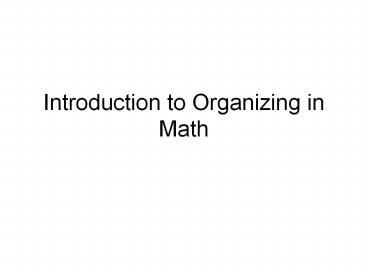Introduction to Organizing in Math PowerPoint PPT Presentation
1 / 17
Title: Introduction to Organizing in Math
1
Introduction to Organizing in Math
2
What is Organizing?
- Organizing is a strategy to detect and understand
patterns of relevant information. - Students identify information they have and must
gather to solve a problem.
3
Key Elements of Organizing
- Students select a graphic organizer to help them
arrange relevant information. - Examples of graphic organizers include
- Graphs
- Tables
- Charts
- Lists
- Concept maps
4
How Does Organizing Help Students?
- Supports them in more easily seeing patterns and
learning mathematical concepts. - Guides their thinking about what they do and
dont know about a problem. - Gives them ideas of ways to approach solving a
problem. - Helps them maintain chunks of information in
memory to use in problem solving.
5
Discussion Questions 1
- How do you explain organizing to your students?
- How does organizing connect with the CCSS Math
Practices? - How can organizing help a struggling student get
unstuck when working with a problem?
6
How Can I Support Students' Use of Organizing?
7
Use Evidence-based Instructional Practices
- Provide Clear Explanations
- Use Varied Examples, Materials, and Models
- Provide Ongoing Formative Assessment
8
Differentiated Instruction
- Plan instruction that considers students'
readiness, learning needs, and interests. - Use a range of technology tools to
- engage learners at varying levels
- engage learners in multiple ways.
- offer students options for demonstrating
understanding and mastery
9
Teacher-Dependent Ways to Differentiate
- By Content
- Different levels of reading or resource
materials, reading buddies, small group
instruction, curriculum compacting, multi-level
computer programs and Web Quests, audio
materials, etc. - By Product
- Activity choice boards, tiered activities,
multi-level learning center tasks, similar
readiness groups, choice in group work, varied
journal prompts, mixed readiness groups with
targeted roles for students, etc. - By Process
- Tiered products, students choose mode of
presentation to demonstrate learning, independent
study, varied rubrics, mentorships,
interest-based investigations
10
Student-Dependent Ways to Differentiate
- By Readiness
- Options in content, topic, or theme, options in
the tools needed for production, options in
methods for engagement - By Profile
- Consideration of gender, culture, learning
styles, strengths, and weaknesses - By Interests
- Identification of background knowledge/gaps in
learning, vary amount of direct instruction, and
practice, pace of instruction, complexity of
activities, and exploration of a topic
11
Discussion Questions 2
- In what ways do you differentiate instruction
when you introduce organizing information to your
students? - What technology tools have you used to enhance
instruction? - What criteria do you use for selecting organizers
to show your students?
12
Provide Clear Explanations Possible Strategies
- Explain how organizing helps us find what we are
looking for or see if something is missing. - Describe the purpose of each kind of organizer
(list, table, graph, concept map, etc.). - Discuss with students the features that make each
kind of organizer helpful. - With each organizer, give students time to think
about how the information is organized.
13
Use Varied Examples, Materials, and Models
Possible Strategies
- Share many examples of each kind of organizer
with students. - Model how to use each organizer to solve
problems. - Give students time to practice using a variety of
organizers to solve different types of problems. - Have students who use different organizers share
their strategies and reasons for using them.
14
Provide Ongoing Formative Assessment Possible
Strategies
- Make sure students understand how to choose and
use organizers before they start tackling
problems. - Note any problems that students have in entering
information into an organizer provide support. - Look for student misconceptions in the use of
organizers re-teach use of organizers as needed. - Have students create and add to a portfolio of
organizers they successfully use to solve
problems.
15
Use Research-Based Strategies and Tools
- To launch the lesson
- During the learning task
- As you bring closure to the lesson
16
Discussion Questions 3
- What challenges do your struggling students face
in using organizers? - What strategies do you use to help students
overcome their challenges? - Which formative assessment strategies do you find
most effective?
17
Disclaimer
- Awarded through a cooperative agreement from the
U.S. Department of education, Office of Special
Education Programs (OSEP), Grant H327G090004-10,
PowerUp What Works was developed by a team of
experts in education, technology, differentiated
instruction/UDL, and special education at the
Center for Technology Implementation, operated by
the American Institutes for Research (AIR) in
collaboration with the Education Development
Center, Inc. (EDC) and the Center for Applied
Special Technology (CAST). - This document contains information from other
public and private organizations that may be
useful to the reader these materials are merely
examples of resources that may be available.
Inclusion of this information does not constitute
an endorsement by the U.S. Department of
Education of any products or services offered or
views expressed. This publication also contains
hyperlinks and URLs created and maintained by
outside organizations and provided for the
reader's convenience. The Department is not
responsible for the accuracy if this information.
Further, the programs/models/resources featured
on this site have not been extensively evaluated
by CTI. This website was created and is
maintained by American Institutes for Research
(AIR) through funding from the U.S. Department of
Education, Award H327G090004. For more
information, send an e-mail to PowerUp_at_air.org.

